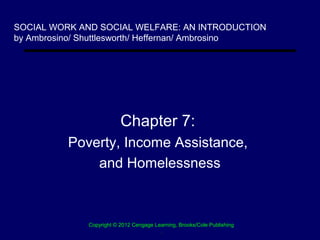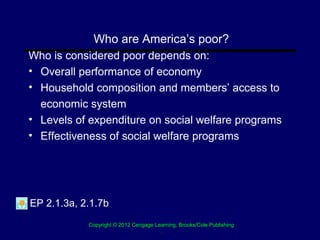Chapter 7 Poverty and How to Help
- 1. SOCIAL WORK AND SOCIAL WELFARE: AN INTRODUCTION by Ambrosino/ Shuttlesworth/ Heffernan/ Ambrosino Chapter 7: Poverty, Income Assistance, and Homelessness Copyright ┬® 2012 Cengage Learning, Brooks/Cole Publishing .
- 2. Empowering Programs with Resources that Enhance Social Work Education Copyright ┬® 2012 Cengage Learning, Brooks/Cole Publishing .
- 3. Social Work: A Competency- Oriented Education ’ü▒ Council on Social Work Education (CSWE) - Defines Educational Policy and Accreditation Standards (EPAs) - Developed 10 ŌĆ£Core CompetenciesŌĆØ and 41 Related ŌĆ£Practice BehaviorsŌĆØ ’ü▒ Every student should master the Practice Behaviors and Core Competencies before completing the program Copyright ┬® 2012 Cengage Learning, Brooks/Cole Publishing .
- 4. Resources Aligned to EPAS 2008 ’ü▒ The Textbook ŌĆō - ŌĆ£Helping HandsŌĆØ icons call attention to content that relates to Practice Behaviors and Competencies - ŌĆ£Competency NotesŌĆØ at the end of the chapter help put the Practice Behaviors and Competencies in practical context Copyright ┬® 2012 Cengage Learning, Brooks/Cole Publishing .
- 5. Resources Aligned to EPAS 2008 (contŌĆÖd) ’ü▒ The Practice Behaviors Workbook developed with the text provides assignable exercises that assist in mastering the Practice Behavior and Competencies ’ü▒ Additional on-line resources can be found at: www.cengage.com/socialwork Copyright ┬® 2012 Cengage Learning, Brooks/Cole Publishing .
- 6. Views on poverty and how to help ŌĆó Multiple views on poverty, what should be done, and who should do it ŌĆó Most people want successful anti-poverty programs in place, but there is lack of agreement about what those programs should be EP 2.1.1a, 2.1.8a Copyright ┬® 2012 Cengage Learning, Brooks/Cole Publishing .
- 7. Conceptualizations of poverty ŌĆó As deprivation ŌĆó As inequality in the distribution of income ŌĆó As culture ŌĆó As exploitation by the ruling class ŌĆó As structure EP 2.1.1a, 2.1.8a Copyright ┬® 2012 Cengage Learning, Brooks/Cole Publishing .
- 8. Defining poverty ŌĆó Inadequate household income when defined by a specific standard ŌĆó Relative poverty ŌĆó Market basket concept EP 2.1.1a, 2.1.8a Copyright ┬® 2012 Cengage Learning, Brooks/Cole Publishing .
- 9. Federal poverty guidelines (2010) Household Income Household Income Size Limit Size Limit 1 $10,380 5 $25,790 2 $14,570 6 $29,530 3 $18,310 7 $33,270 4 $22,050 8 $37,010 EP 2.1.1a, 2.1.8a Copyright ┬® 2012 Cengage Learning, Brooks/Cole Publishing .
- 10. Who are AmericaŌĆÖs poor? Who is considered poor depends on: ŌĆó Overall performance of economy ŌĆó Household composition and membersŌĆÖ access to economic system ŌĆó Levels of expenditure on social welfare programs ŌĆó Effectiveness of social welfare programs EP 2.1.3a, 2.1.7b Copyright ┬® 2012 Cengage Learning, Brooks/Cole Publishing .
- 11. The poor are a diverse group ŌĆó 14% of U.S. population live in poverty ŌĆó African Americans and Latinos are almost 3 times more likely to be poor than whites ŌĆó 1 in 10 persons 65 and older is poor ŌĆó Almost 30% of female householders live in poverty ŌĆó 1 in 3 African American and a like number of Latino children lives in poverty compared to less than 1 in 10 white children EP 2.1.3a, 2.1.7b Copyright ┬® 2012 Cengage Learning, Brooks/Cole Publishing .
- 12. Debunking stereotypes about the poor ŌĆó Not all poor people are on welfare ŌĆō many are two-parent families with both parents working full-time, often in minimum wage jobs with few or no benefits ŌĆó 20% of families living in poverty line have a working family member EP 2.1.3a, 2.1.7b Copyright ┬® 2012 Cengage Learning, Brooks/Cole Publishing .
- 13. Social Security Act of 1935 ŌĆó Cornerstone of American social welfare policy ŌĆó Set tone for federal support for individuals and families ŌĆó The act has been modified many times over the years to create new programs, modify existing programs, or do away with programs EP 2.1.3a, 2.1.7b Copyright ┬® 2012 Cengage Learning, Brooks/Cole Publishing .
- 14. War on poverty is lost ŌĆó Economic Opportunity Act creates a plethora of domestic anti-poverty programs ŌĆó Many of these programs were ill-conceived, poorly run, or not sustainable ŌĆó White House preoccupied with Vietnam War ŌĆó Welfare rolls escalate ŌĆó Economy falters, new demands for belt-tightening EP 2.1.3a, 2.1.7b Copyright ┬® 2012 Cengage Learning, Brooks/Cole Publishing .
- 15. Last-ditch effort to reduce welfare rolls ŌĆó Public outcry about ŌĆ£evils of welfareŌĆØ intensifies ŌĆó Welfare reform efforts focus on work and personal responsibility ŌĆó Family Support Act (1988) offers glimmer of hope, but ends up being too little, too late ŌĆó Lack of jobs that pay living wage keep welfare rolls high ŌĆó ŌĆ£Contract with AmericaŌĆØ is launched EP 2.1.3a, 2.1.7b, 2.1.8a Copyright ┬® 2012 Cengage Learning, Brooks/Cole Publishing .
- 16. End to welfare as we knew it ŌĆó Republicans cut funds for low-income children, families, elderly, people with disabilities ŌĆó Block grants to states ŌĆó Personal Responsibility and Work Opportunity Reconciliation Act (1996) eliminates welfare entitlement, creates lifetime limit on benefits and strict standards for complying with the law EP 2.1.3a, 2.1.7b, 2.1.8a Copyright ┬® 2012 Cengage Learning, Brooks/Cole Publishing .
- 17. End to welfare as we knew it (contŌĆÖd) ŌĆó Welfare rolls decline precipitously ŌĆó Most people who exit welfare are employed in low- paying, ŌĆ£dead endŌĆØ jobs with few or no benefits ŌĆó Community agencies unable to pick up slack created by welfare reform initiatives ŌĆó White House touts declining welfare rolls as proof that welfare reform work EP 2.1.3a, 2.1.7b, 2.1.8a Copyright ┬® 2012 Cengage Learning, Brooks/Cole Publishing .
- 18. Current strategies for addressing poverty ŌĆó Strong market and family system ŌĆó Public assistance programs (TANF, Medicaid, SSI, general assistance) ŌĆó In-kind benefits and tax credits (Earned Income Tax Credit, food benefits, housing assistance) EP 2.1.1a, 2.1.8a, 2.1.8b Copyright ┬® 2012 Cengage Learning, Brooks/Cole Publishing .
- 19. Other antipoverty programs ŌĆó Direct provision of necessities ŌĆó Empowerment efforts ŌĆó Job training ŌĆó Restructuring institutions to produce greater access to economic opportunity ŌĆó No easy solutions ŌĆō most experts suggest multiple strategies needed EP 2.1.1a, 2.1.8a, 2.1.8b Copyright ┬® 2012 Cengage Learning, Brooks/Cole Publishing .
- 20. 2010 and beyond ŌĆó Single, low-income mothers and those receiving cash assistance have high rates of psychiatric illness ŌĆó Rural mothers, especially poor, single mothers, face formidable barriers to employment ŌĆó Reductions in food allotment results in high levels of food insecurity among non-citizen parents EP 2.1.1a, 2.1.8a Copyright ┬® 2012 Cengage Learning, Brooks/Cole Publishing .
- 21. Impact of poverty on children ŌĆó Family stress and conflict ŌĆó Limited opportunities for learning at home ŌĆó Lower-quality child care ŌĆó Inadequate nutrition ŌĆó Inadequate housing; increased homelessness ŌĆó Lack of transportation; increased isolation ŌĆó Factors interfere with brain development EP 2.1.6b Copyright ┬® 2012 Cengage Learning, Brooks/Cole Publishing .
- 22. TANF reauthorization plan (2006) ŌĆó Strengthen federal-state partnership ŌĆó Maintain self-sufficiency through work and additional constructive activities ŌĆó Promote child well-being and healthy marriages ŌĆó Encourage abstinence and prevent teen pregnancy ŌĆó Improve program performance EP 2.1.6b Copyright ┬® 2012 Cengage Learning, Brooks/Cole Publishing .
- 23. TANF reauthorization plan (2006) ŌĆó Enhance child support enforcement ŌĆó Reform food stamps to promote work EP2.1.6b Copyright ┬® 2012 Cengage Learning, Brooks/Cole Publishing .
- 24. Homelessness A homeless person: Someone who lacks fixed, regular and adequate night-time residence, andŌĆ”has primary night time residency that is a supervised shelter providing temporary living accommodations or a public or private place not designed for use as regular sleeping accommodations for human beings. EP 2.1.1a, 2.1.3a, 2.1.8a Copyright ┬® 2012 Cengage Learning, Brooks/Cole Publishing .
- 25. Characteristics of homeless individuals ŌĆó Youth ŌĆó Elderly ŌĆó Women and families ŌĆó People of color ŌĆó Survivors of domestic violence ŌĆó Veterans ŌĆó People with mental illness and addiction EP 2.1.1a, 2.1.3a, 2.1.8a Copyright ┬® 2012 Cengage Learning, Brooks/Cole Publishing .
- 26. Homelessness and mental illness ŌĆó 20-25% of single adults who are homeless suffer from some type of severe mental illness ŌĆó Many people become homeless as a result of a mental illness ŌĆó Others experience emotional problems as a result of being homeless EP 2.1.1a, 2.1.3a, 2.1.8a Copyright ┬® 2012 Cengage Learning, Brooks/Cole Publishing .
- 27. Homelessness and mental illness (contŌĆÖd) Homeless people with mental disorders face more barriers to obtaining jobs, are in poorer health, and have more contact with the legal system than housed individuals EP 2.1.1a, 2.1.3a, 2.1.8a Copyright ┬® 2012 Cengage Learning, Brooks/Cole Publishing .
- 28. Homelessness and employment ŌĆó Inadequate or no employment and lack of affordable rental housing leave many people homeless ŌĆó It is difficult to find a job without a permanent address ŌĆó It is difficult to keep a job when homeless, though 20% of urban homeless are employed EP 2.1.1a, 2.1.3a, 2.1.8a Copyright ┬® 2012 Cengage Learning, Brooks/Cole Publishing .
- 29. Homelessness and healthcare Homeless people: ŌĆó Often experience poor health ŌĆó Are at risk for tuberculosis, HIV/AIDS, diabetes, hypertension, addictive disorders, and mental disorders ŌĆó Lack access to good nutrition, and adequate personal hygiene ŌĆó Are likely have no health insurance EP 2.1.1a, 2.1.3a, 2.1.8a Copyright ┬® 2012 Cengage Learning, Brooks/Cole Publishing .
- 30. Homelessness and Isolation Homeless people: ŌĆó Are likely to be isolated from families and traditional social roles ŌĆó Often have no ties to a support network; loss of social support systems extends length of time being homeless ŌĆó Tend to remain isolated even when they find housing because of stigma of being homeless EP 2.1.1a, 2.1.3a, 2.1.8a Copyright ┬® 2012 Cengage Learning, Brooks/Cole Publishing .
- 31. Policies and programs ŌĆó Stewart B. McKinney Homeless Assistance Act ŌĆó Housing Affordability for America Act ŌĆó Other programs focus mostly on emergency assistance, not long-term solutions or root causes of homelessness EP2.1.8a, 2.1.8b Copyright ┬® 2012 Cengage Learning, Brooks/Cole Publishing .
- 32. Ending homelessness ŌĆó Affordable housing ŌĆó Employment and education opportunities ŌĆó Discharge planning from institutions ŌĆó Child care and education for children ŌĆó Comprehensive health/mental health care ŌĆó Programs that make it possible for homeless people to accumulate financial assets EP 2.1.8a, 2.1.8b Copyright ┬® 2012 Cengage Learning, Brooks/Cole Publishing .
- 33. Role of social workers in fighting poverty ŌĆó Public assistance programs ŌĆó Faith-based organizations ŌĆó Housing programs ŌĆó Health and mental health clinics ŌĆó School-based programs ŌĆó Emergency shelters ŌĆó Advocacy programs EP 2.1.1a, 2.1.8b Copyright ┬® 2012 Cengage Learning, Brooks/Cole Publishing .
- 34. Eliminating poverty has been elusive ŌĆó ItŌĆÖs not that we havenŌĆÖt tried (e.g., War on Poverty, Great Society) ŌĆó Individualist perspective remains strong ŌĆó Capitalism requires an underclass in order to thrive ŌĆó Globalism has only amplified the problem ŌĆó Political will to end poverty doesnŌĆÖt seem to exist ŌĆó Domestic priorities have taken a back seat EP 2.1.1a, 2.1.8a, 2.1.9b Copyright ┬® 2012 Cengage Learning, Brooks/Cole Publishing .

































